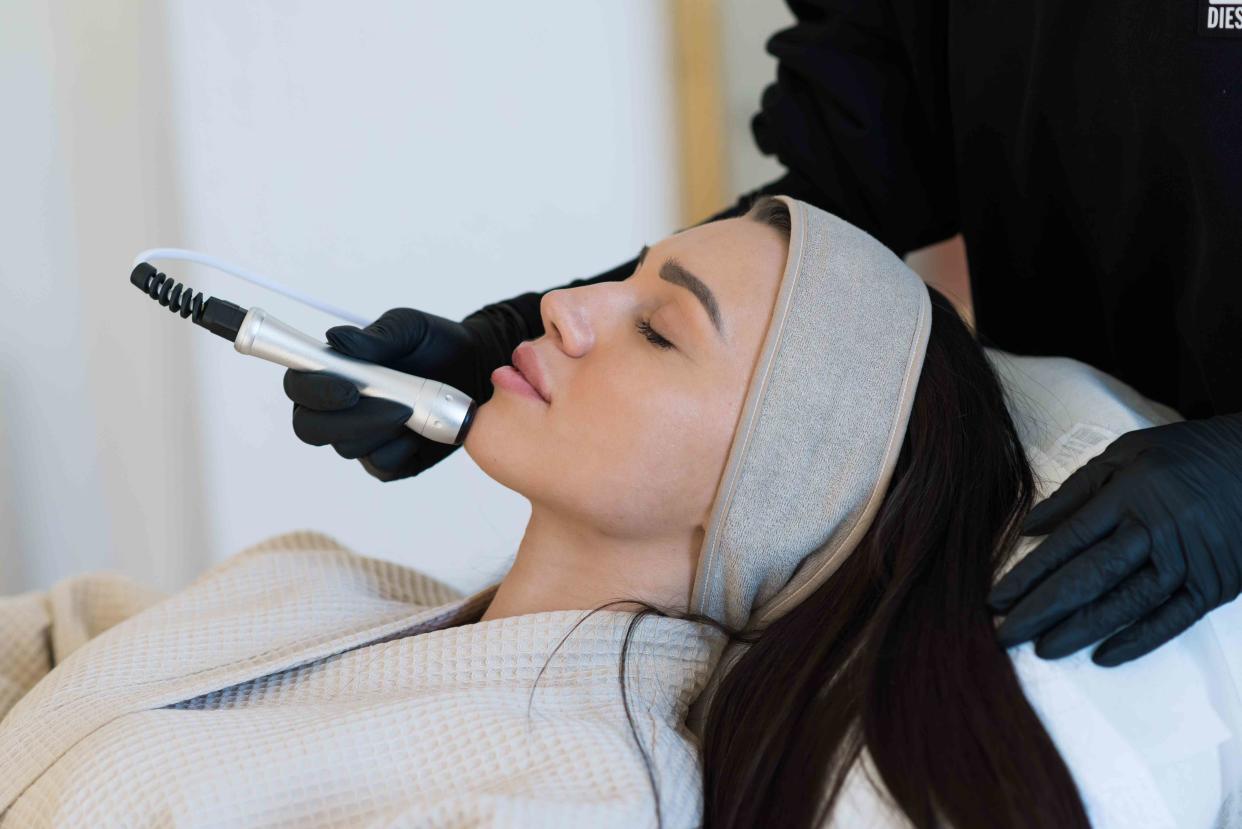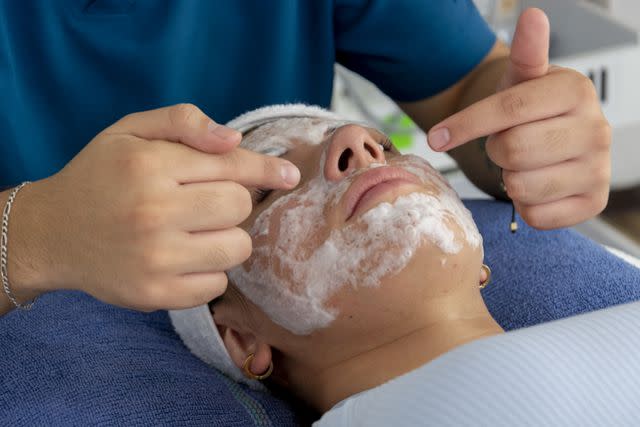Everything You Need to Know About Hydrafacials

Janko Maslovaric / Getty Images
When a TikTok beauty trend edges into the 1-billion views territory, it’s only natural to feel intrigued. So if you’ve been Googling and trying to justify the price of a Hydrafacial, know that you’re not alone. While $200 to $300 for a chemical exfoliation facial might feel like a lot, many dermatologists, estheticians, and everyday TikTokers (not to mention folks off the platform) tout that it’s well worth the splurge. In fact, according to the 2022 Plastic Surgery Statistics Report, skin resurfacing treatments, like the Hydrafacial, ranked third in the top five minimally invasive procedures for 2022.
Ready to discover why the hydrafacial cost is well worth investing in? Keep reading to learn more from three experts.
Meet Our Expert
Dr. Jennifer Gordon is a board-certified dermatologist at Westlake Dermatology & Cosmetic Surgery.
Dr. Andrew Peredo is a plastic surgeon in New York City.
Karen Fernandez is the lead aesthetician at SkinSpirit.
Hydrafacial Cost
As we mentioned, a Hydrafacial costs around $200 to $300, however, Dr. Peredo is quick to remind us that it depends on where you go. As always, clinics and dermatologist offices in metropolitan areas will be more expensive than those in suburbs. The person who administers the facial also plays a role in how expensive it will be. Generally, dermatologists cost more than estheticians.
“In the grand scheme of things that we offer, Hydrafacial and DiamondGlow are some of the best bang for your buck when you are looking for a deep clean and a glow,” Dr. Gordon adds. “The results are instant and you leave feeling rejuvenated and refreshed.”
Benefits of a Hydrafacial
Hydrafacials offer a slew of complexion-improving benefits. As the name suggests, the facial is incredibly hydrating—but that’s not all. “Hydrafacials deep clean and plump the skin, leaving you with a dewy glow,” says Dr. Gordon.
To offer such results, Hydrafacials unfold over three distinct steps. During the initial cleansing phase, a gentle peel is applied to slough away dead skin cells and diminish the appearance of dark spots. Then, during the extraction period, the device gently sucks any remaining gunk out of pores, lending to a tighter-looking complexion post-application. Finally, hydrating and nourishing ingredients are infused back into the skin to complete the glow-boosting facial. As for the exact ingredients used in the Hydrafacial, it depends on which boosters you choose. After all, the treatment is designed to be customized to the user.
According to Dr. Peredo, Hydrafacials typically take around 30 minutes to complete and don’t require any down time. “The treatment does not typically leave you with irritation or redness,” he explains. “This means you can get the Hydrafacial before a big event where you want your skin to be glowing (or any time of course). Right after the facial, you will have an immediate glow, and your skin will feel hydrated.”
Related: What Does a Facial Do For Your Skin?
Results and Maintenance
Hydrafacials might offer instant dewy results but they’re by no means fleeting. Generally speaking, Dr. Peredo says that results will last for five to seven days. “The best results will be achieved when you are consistent with your treatments,” he adds.
Of course, having a solid at-home skincare routine can help prolong the results. “The best way to mimic the results of a Hydrafacial begins by deep cleansing your skin, exfoliating physically, exfoliating chemically, hydrating, and then deeply moisturizing your skin,” Dr. Peredo says. However, he does not recommend at-home pore vacuums to mimic the Hydrafacial. Instead, he suggests coming in for a follow-up treatment when you feel the need to get hands-on at home. “Pore vacuums can harm your pores more and increase the chances of scarring,” he warns.
While the most noticeable results of a Hydrafacial only last for about a week, Dr. Peredo and Dr. Gordon agree that it’s best to only get one Hydrafacial every month or so. Ultimately, though, it depends on your skin type. “It may be recommended for some to receive the treatment every two to four weeks,” Dr. Peredo adds.
Tips
Still not sure how often to go? Your dermatologist, nurse practitioner, or esthetician will be able to tell you. But, for what it’s worth, Dr. Gordon reveals that most patients go every one to three months.

Getty Images
Hydrafacial vs DiamondGlow
Back up: What’s DiamondGlow? Essentially, it’s the Allergan Aesthetics (ie: Botox’s parent company) version of Hydrafacial.
“A DiamondGlow is an all-in-one facial that simultaneously cleanses the pores, exfoliates the skin with diamond tip microdermabrasion, and infuses the skin with custom SkinMedica specialty corrective serums selected especially for your needs,” says Fernandez. “Since all three actions—cleansing, exfoliating, and infusing—happen simultaneously, it's really quick and efficient. It's great for just about everybody, and leaves the skin feeling refreshed, hydrated, clean and rebalanced, and infused with hand-picked actives to address everything from acne and congestion to hydration and anti-aging.”
When choosing between a Hydrafacial and DiamondGlow, there are a couple of things to consider. First, the type of exfoliation. “The main difference between the two is that DiamondGlow offers manual exfoliation while the Hydrafacial delivers chemical exfoliation,” Dr. Peredo says, noting that the DiamondGlow is a great option for people looking to slow down the appearance and effects of aging. This might not seem like a big difference, but it can be a deciding factor based on your skin type. If you know your skin reacts poorly to physical exfoliation, opt for a Hydrafacial; if you know you’re sensitive to chemical exfoliants, go with the DiamondGlow.
Then there’s the price. If you’re on a budget, DiamondGlow may be the better choice. “This treatment is a little less expensive than the Hydrafacial,” Dr. Peredo says. Typically, DiamondGlow facials cost right around $200, Fernandez shares.
The Takeaway
If you’re looking for instantly smoother, brighter, dewier-looking skin, the Hydrafacial is worth investing in. To determine if it’s the right cosmetic treatment for you, book a consultation with your dermatologist or at a skin clinic near you.
Frequently Asked Questions
Who is the best candidate for a Hydrafacial?
Anyone and everyone can enjoy a Hydrafacial. That said, Dr. Peredo says that they tend to be best for younger patients since they address texture and hydration in a minimally-invasive way. “It’s also a great introductory to laser treatments,” he adds, noting that you can opt for laser add-ons during your Hydrafacial treatment.
Is the Hydrafacial worth the cost?
As always, whether or not a treatment is worth it is subjective. That said, both Dr. Peredo and Dr. Gordon agree that the Hydrafacial is worth considering. “I believe that the Hydrafacial is worth the cost because of the amount of benefits it provides,” Dr. Peredo says. “You also see results very quickly following the treatment.”
For more InStyle news, make sure to sign up for our newsletter!
Read the original article on InStyle.

